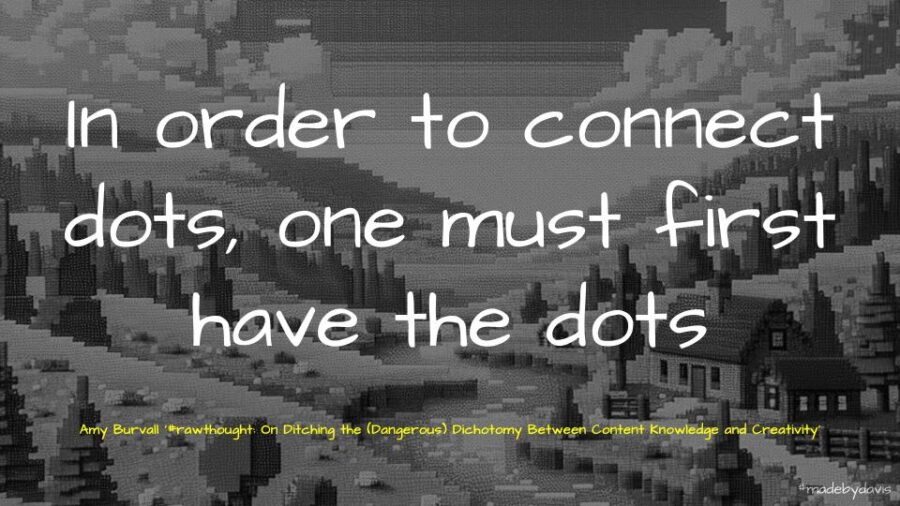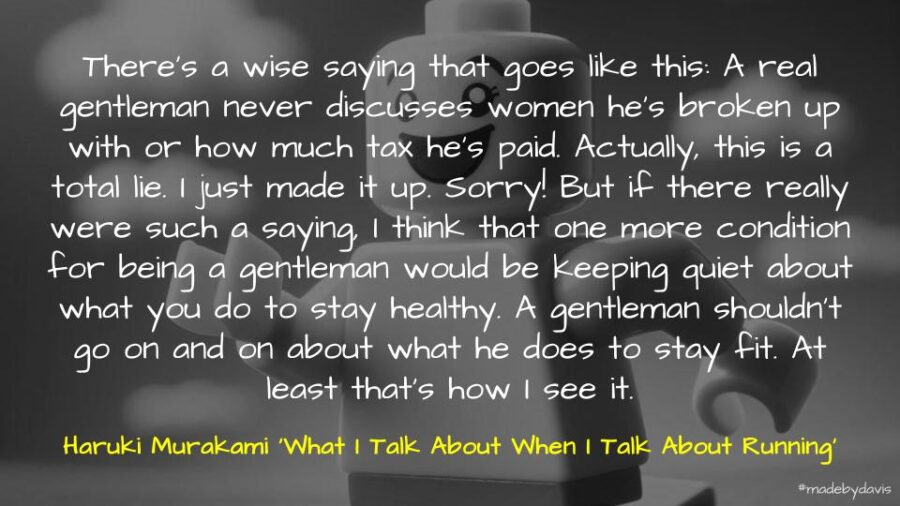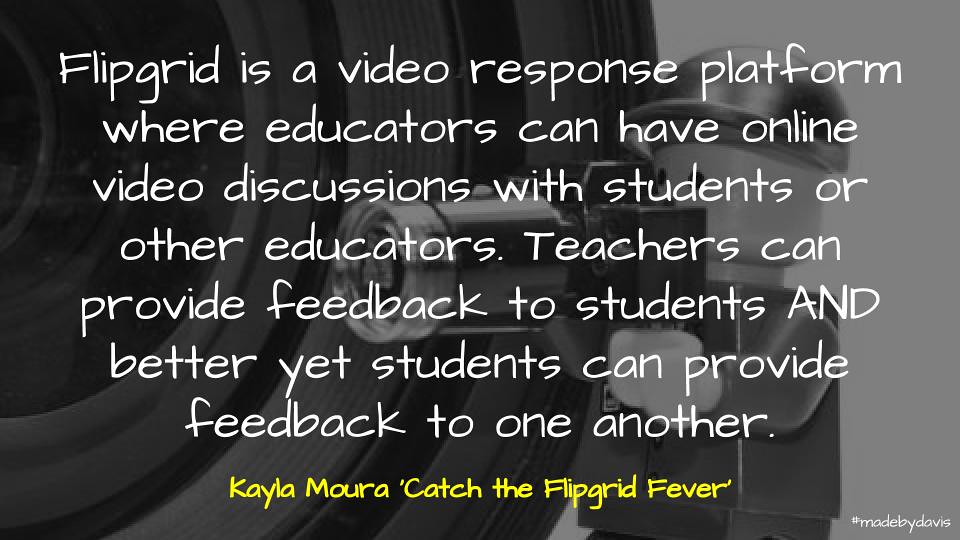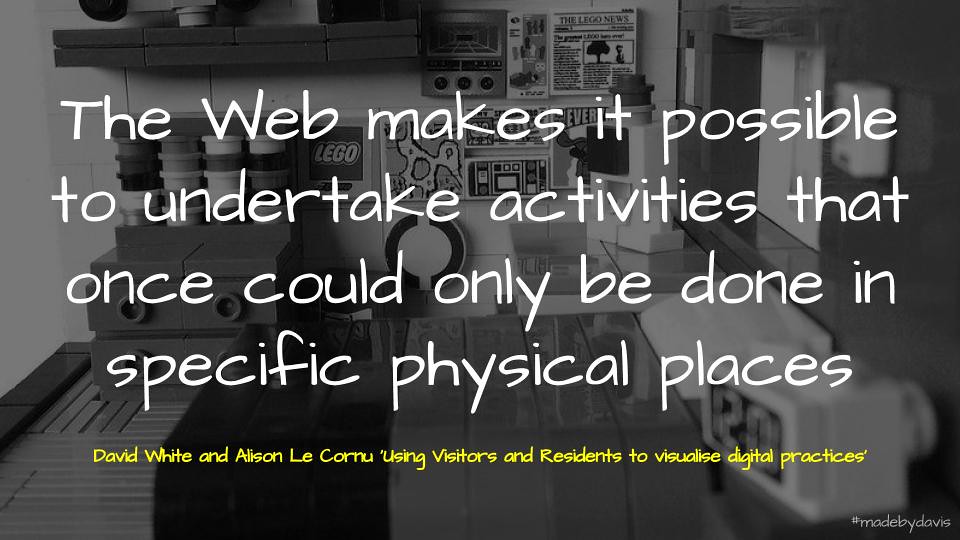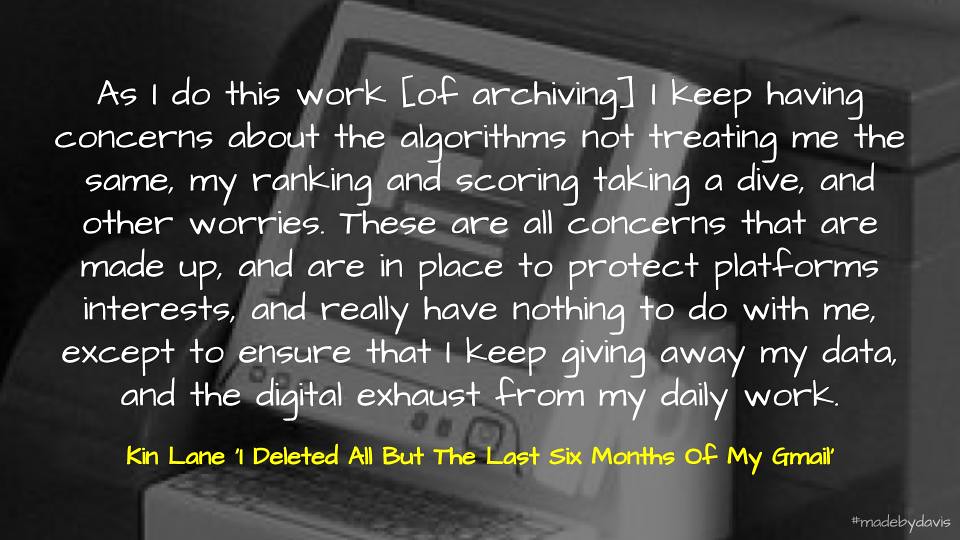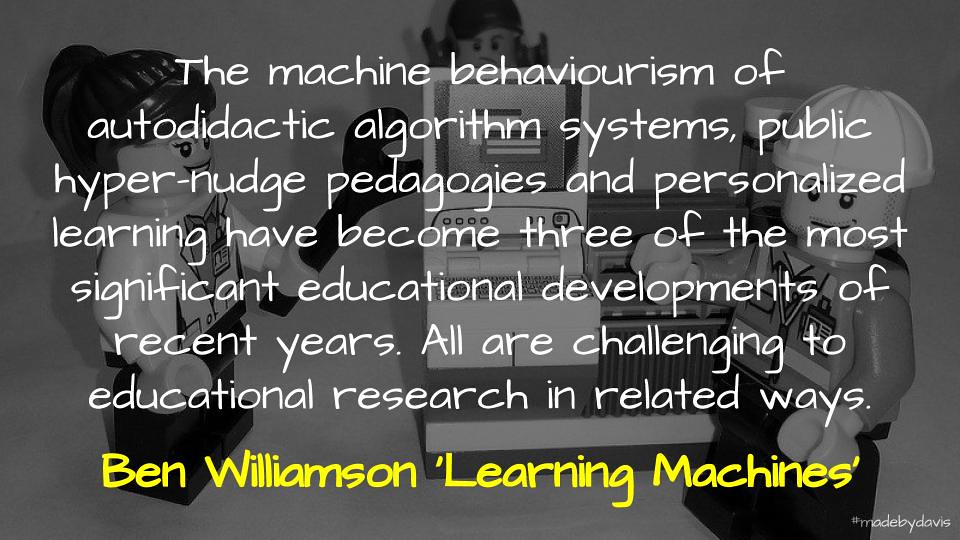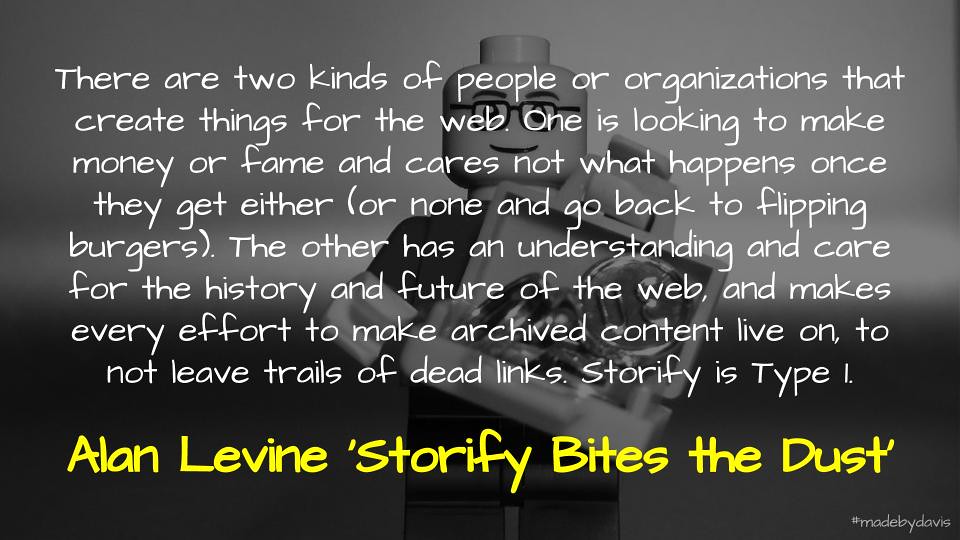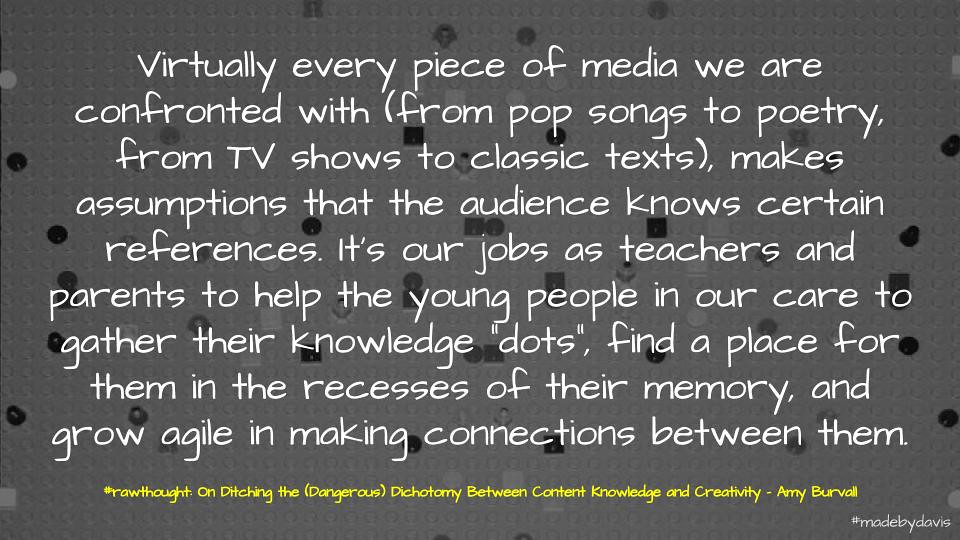I remember there was a time when I would choose one word to focus on each year. Since putting my newsletter on hiatus, I have not had the same interest in such methodical approaches. However, if I had a word for this year, it may well have been books.
This year I really doubled down on reading books. It is not that I had stopped, but I felt that I was spending more time on other forms attention, such as online posts, music and podcasts. I was bugged by something that AJ Juliani posted a few years back about books being ‘the purest forms of creativity and thought’:
I love creative work, and quite frankly, probably spend too much time thinking of new projects and ideas (as well as books and blog posts!). But, I’ve found that spending time reading every day has helped ground me in high-quality content and information. There is something special about a book that a blog post or article cannot replicate. Maybe everyone does not feel this way, but books (to me) are one of the purest forms of creativity and thought.
Source: How to Read More Books (A Nerdy Solution) by A.J. Juliani
Now I am not sure about ‘purest’, but I feel that a book, even poorly written, is going to have been put through the fire of thought and criticism by nature of the medium more than say a social media hot-take.
Like Juliani, I have really doubled-down on audiobooks. I get these from a number places, whether it be purchasing from Libro.fmor Audible, as a part of the ‘Plus’ collection associated with on-off Audible subscription, as a part of my monthly audiobook minutes associated with my Spotify Premium subscription, or via subscriptions offered by the local library, such as BorrowBox and Libby. If I cannot find an audiobook, I also listen via the text-to-speech function using Moon Reader application. This is usually the same application I use to annotate digital texts too.
Here then are a list of books that I read this year:
Non-Fiction
- All In by Joel Selwood – A sporting memoir that touches on life on and off the field when it comes to leadership.
- Wifedom: Mrs Orwell’s Invisible Life by Anna Funder – a fascinating inquiry into the life and influence of Eileen O’Shaughnessy on her husband, George Orwell
- On Tyranny: Twenty Lessons from the Twentieth Century by Timothy Snyder – a series of instructions on how to combat the rise of tyranny, such as “Defend institutions”, “Remember professional ethics”, and “Believe in truth”.
- Killing for Country by David Marr – a detailed saga of politics and power in the colonial world stemming from Marr’s own family history.
- Strive by Adam Fraser – an exploration of ‘happiness’ as being a challenge just outside our reach.
- The Middle Passage: From Misery to Meaning in Midlife by James Hollis – A guide for reimagining midlife as an opportunity to transform our lives.
- The Writer’s Crusade: Kurt Vonnegut and the Many Lives of Slaughterhouse-Five by Tom Roston – An examination of the connections between Kurt Vonnegut’s life, Slaughterhouse-Five, and whether he actually suffered from Post-Traumatic Stress Disorder.
- Adventures in Time: The First World War by Dominic Sandbrook – A book zooming in and out of the First World War, picking out the interesting points, rather than getting too bogged down by nuisance and complexity.
- So You Want to Live for Longer? by Norman Swan – An exploration of how to stay young and healthy for longer.
- Neoliberalism: A Very Short Introduction by Manfred Steger and Ravi Roy – An exploration of what we talk about when we talk about neoliberalism.
- Poststructuralism: A Very Short Introduction by Catherine Belsey – A general introduction to poststructuralism based around language, culture, desire and truth.
- Poetry: A Very Short Introduction by Bernard O’Donoghue – An extrapolation of the many ideas associated with poetry, a book with as many questions as conclusions.
- Range by David Epstein – A provocation about the many benefits of breadth in a complex world, rather than a straight-forword manual for success.
- The Human Condition by Hannah Arendt – An exploration of human activity, focusing on ideas of labor, work and action.
- Magic Pill by Johann Hari – A look at the obesity epidemic and the rise of drugs being used to fight it
- Memories, Dreams, Reflections by Carl Jung – Jung’s psychic journey through his life and his ongoing engagement with the unconscious.
- Lifelong Kindergarten by Mitchel Resnick – A book written for those who care about kids, learning, and creativity.
- Fooled by Randomness by Nassim Nicholas Taleb – An exploration of the ways we are unaware of the randomness, whether it be by overestimating causality or seeing the world as explainable.
- Did I Ever Tell You This? by Sam Neill – A memoir written as a distraction while receiving treatment for cancer.
- How to Do Nothing by Jenny Odell – A critique of the way even our attention has been capitalised upon through our use of technology and a meditation for how to do something more meaningful and human.
- Why Marx Was Right by Terry Eagleton – A response to ten theoretical objections to Marxism.
- Fake by Stephanie Wood – An examination into the perils of finding love and connection via online spaces.
- Principled by Paul Browning – An exploration of trust destroyed and regained and as it does, aims to impart practical advice that can be adopted by any leader wishing to become a more trustworthy leader.
- The Internet is Not What You Think by Justin E.H. Smith – A dive into the basis of the internet in attention, the link to the past in figures such as Liebnez and Lovelace, the blur of where it actually starts and stops, as well as metaphor as a way of understanding.
- The Season by Helen Garner – A document of a moment in life, time and culture, capturing all the ebbs and flows of an U16 football season.
Music Books
- Listen by Michel Faber – An exploration into how and why we listen to music
- Sweet Dreams by Dylan Jones – An exploration into the music that influenced the New Romantics and those caught up in the movement.
- Shiny and New by Dylan Jones – Ten moments in music to explore the eighties.
- Retromania by Simon Reynolds – An inquiry into the the different ways that the past plays out in music.
- Kraftwerk: Future Music from Germany by Uwe Schütte – An exploration of the origins, output and legacy of Kraftwerk.
Fiction
- The Old Man and the Sea by Ernest Hemmingway
- Lolita by Vladimir Nabokov
- The Stranger by Albert Camus
- A Clockwork Orange by Anthony Burgess
- Riddley Walker by Russell Hoban
- The Passenger by Cormac McCarthy
- Boy Swallows Universe by Trent Dalton
- Stella Maris by Cormac McCarthy
- Walkaway by Cory Doctorow
- All the Pretty Horses by Cormac McCarthy
- As I Lay Dying by William Faulkner
- The Midnight Zoo by Sonya Hartnett
- Cat’s Cradle by Kurt Vonnegut
- The Unknown Terrorist by Richard Flanagan
- Lola in the Mirror by Trent Dalton
- For Whom the Bell Tolls by Ernest Hemmingway
- A Room with a View by E.M. Forster
- No Country for Old Men by Cormac McCarthy
- The Scarlet Letter by Nathanial Hawthorn
- Slaugherhouse Five by Kurt Vonnegut
- Middlemarch by George Eliot
- The Dispossessed by Ursula Le Guin
- The Sea, The Sea by Iris Murdoch
- Breakfast of Champians by Kurt Vonnegut
- Fear and Loathing in Las Vegas by Hunter S. Thompson
- Fahrenheit 451 by Ray Bradbury
- The Martian Chronicles by Ray Bradbury
- Kafka on the Shore by Haruki Murakami
- Treasure Island by Robert Louis Stevenson
- Turn of the Screw by Henry James
- The Day of the Triffids by John Wyndham
- Men Without Women by Haruki Murakami
- A Passage to India by E.M. Forster
- A History of the World in 10 1/2 Chapters by Julian Barnes
- Stone Yard Devotional by Charlotte Wood
- Our Man in Havana by Graham Greene
- Klara and the Sun by Kazuo Ishiguro
- Of Mice and Men by John Steinbeck
- The Plot Against America by Philip Roth
- Never Let Me Go by Kazuo Ishiguro
- Such is Life by Joseph Furphy
- The Catcher in the Rye by J.D. Salinger
- Norwegian Wood by Haruki Murakami
- The Silmarillion by J.R.R. Tolkien
- The Great World by David Malouf
- The Hunger Games series by Suzanne Collins
I do not necessarily have a rating system, however these are the books that I have managed to reflect on in more detail:
- All In (Joel Selwood)
- Boy Swallows Universe (Trent Dalton)
- Lola in the Mirror (Trent Dalton)
- The Unknown Terrorist (Richard Flanagan)
- So You Want To Live Younger Longer? (Dr. Norman Swan)
- The Sea, The Sea (Iris Murdoch)
- Why Don’t Students Like School (Daniel Willingham)
- Memories, Dreams, Reflections (Carl Jung and Aniela Jaffé)
- Magic Pill (Johann Hari)
- Did I Ever Tell You? (Sam Neill)
- Sweet Dreams – The Story of the New Romantics (Dylan Jones)
- Kraftwerk – Future Music from Germany (Uwe Schütte)
By numbers, I feel I have read (or listened to) a lot this year. However, one of the challenges I still find is carving out the time and space to write and make sense of my reading. (Like this piece, which was pulled together over several weeks.) J. Hillis Miller’s once wrote that “there is always already writing as an accompaniment to reading,” however like food past its used by date, I fear that this ‘writing’ sometimes goes off before being processed and turned into muscle, fibre and energy, and therefore gets added to compost to be broken down, or worse, sent to landfill. Although I feel like my commonplace blog is littered with guides collected from the web on how to ‘remember everything’ (such as this), I worry that there are some books that I remember very little about. Too often my initial seeds of thoughts will be added to my notes, but never quite getting beyond that.
Although books might be more pure, I worry that without stopping and reflecting that they just become another form of mid-level consumption? This is something that Alan Jacobs has discussed:
you could listen to a Sally Rooney novel on Audible while chopping the veggies. Same, basically. This is what I think about almost everything from current big-studio Hollywood movies to new literary fiction to music by Taylor Swift or Beyoncé: it’s … okay. It doesn’t offend.
Source: more rational choices – The Homebound Symphony by Alan Jacobs
I also wonder if by listening to a book, it is easy to “chew it less”. You get through one book, only to be offered the next one to continue the consumption. I worry that reading without writing is not in fact reading at all?
But then I read something from Austin Kleon and was left wondering if maybe reading without intent was in fact ok?
A book doesn’t need to have a “takeaway”, it only needs to take you away.
Source: Instragram by Austin Kleon
More than ok, maybe reading is the perfect medicine at times, as is captured by the idea of bibliotherapy?
Reading has been shown to put our brains into a pleasurable trance-like state, similar to meditation, and it brings the same health benefits of deep relaxation and inner calm. Regular readers sleep better, have lower stress levels, higher self-esteem, and lower rates of depression than non-readers. “Fiction and poetry are doses, medicines,” the author Jeanette Winterson has written. “What they heal is the rupture reality makes on the imagination.”
Source: Can Reading Make You Happier? by Ceridwen Dovey
Or as Kin Lane captured so well, reading a book is answer to a lot of things.
Reading a book is the answer for a lot of what troubles me. When I’ve had to much screen time–read a book! When I’m tired from work and want to turn on the TV–read a book. When I’m frustrated with the current state of things in this country–read a book. When I can’t shut down the voices in my head because I’m spinning out about something–read a book.
Source: Reading a Book is The Answer by Kin Lane
In the end, I probably need to work on developing better habits when it comes to reading, but I might also need to give myself more permission sometimes to just walk away at times. Maybe, to borrow from Doug Belshaw, it is okay not to have an opinion on everything?
